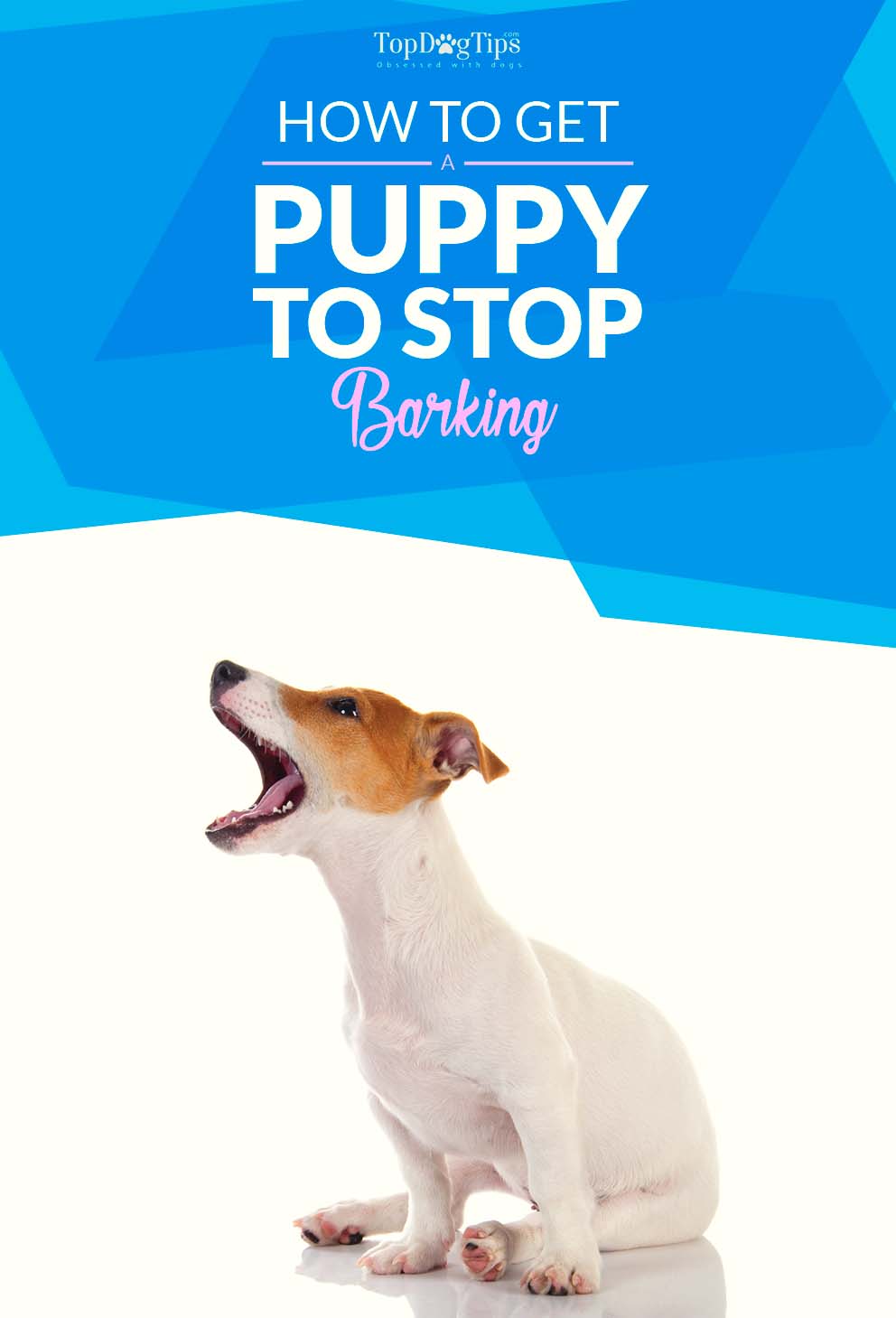
Table of Contents
Is your puppy barking mad? If so, take solace in knowing that it is completely natural and normal behavior. Still, it's extremely frustrating to listen to a dog bark all day. If you're willing to learn how to get a puppy to stop barking, you'll have to put in some time and effort but you'll have a much quieter dog in the end.
Barking is your puppy’s way of communicating with you and it’s not possible to completely eradicate a puppy’s barking, barking is part of the package! It’s vital to understand your puppy’s reasons for barking from a doggy perspective before you can resolve it.
Once you do however, excessive barking can be controlled with a strict routine and repetitive commands so both you and your pup can enjoy a quiet, stress-free home. Puppies will bark at various triggers, and understanding these cues is the first step to resolving the problem of excessive barking.
READ ALSO: 15 Best Puppy Potty Pads for Toilet Training Dogs
How to Get a Puppy to Stop Barking
Puppies have instinctual and learned cues that provoke them to bark. They often yap when playing with other dogs, and give out short happy barks when they’re playing with chew toys by themselves. you or other dogs or while scampering around your ankles.
Puppies and dogs will bark as a form of territorial warning; it’s their first line of defense against what they see as an intruder in their space. This type of bark is aggressive, loud and harsh, and your dog will be tense and alert. Unfortunately, a puppy doesn’t understand when the ‘intruder’ is one of your friends or the mailman.
Your puppy may also bark at you if you happen to wear a hat or a hood as most pups are afraid when a face is covered. They can’t see your expressions and body language, and this can be very intimidating. In his eyes you could be a burglar, the bogey man or a threat.
Puppies will also bark out of loneliness or boredom. If puppies are left alone for long periods of time they get very upset and can bark compulsively. They may also become destructive.
Barking is also a way of commanding your attention if a puppy is hungry, bored or needs to go outside. Remember that barking is your dog's way of communicating. If you're not meeting his needs, he's going to let you know.
Puppies will naturally bark out of fear if they are surprised or startled as a warning to the object or person that startled them, much like we might yelp if someone jumped out of a doorway at us. Though you may find it incredibly embarrassing to find your cuddly puppy barking like a mad thing and nipping at the ankles of your best friend or neighbor, remember it’s in puppy’s genes and he has his reasons.
Understanding your puppy’s point of view will help you have patience and be kind when training him to stop barking excessively. It’s up to you to get an idea of which barks mean what, and to understand the reasons for his barking. With time and a little pup psychology you can find a way to resolve the problem. Take a couple of days to watch him and take notes of when he barks to find out his triggers.
RELATED: More Tips to Stop Dog Barking Using Command Training
Training Your Puppy to Stop Barking
To begin training, do not under any circumstances shout or yell back in response to your puppy’s barking! He can’t help it. Confident pups will think you are barking along and bark all the more, and anxious puppies will be frightened and get stressed out.
Calm body language and a gentle but firm voice is one of the keys to learning how to get a puppy to stop barking. So as not to confuse or frustrate your puppy, it is very important that all your family learn the anti-barking routine and that everyone carries out the commands as specified below.
Dog treats should be used in the training program. However, you should only give your puppy very small treats, or even cut the treats up into tiny pieces to ensure he doesn’t begin to gain weight. You can buy training treats that are specifically made very small for this purpose. They are about the size of a pea.
RELATED: Electronic Dog Collars and How to Use Them Safely
Keep the treats at the ready in your pocket, and then set your limits. When your puppy starts barking, you can allow him to bark for a maximum of three times. This enables him to give his bark signal and feel like he’s helping. For example three barks when someone is approaching the house, or three barks to go outside.
After the three barks say, ‘Okay,’ and then give a food treat from out of your pocket and give lots of praise. Having dutifully helped you, your puppy deserves a just reward. In time, your pup will associate barking three times only as treat and high praise time.
Many people find that their dogs ferociously bark at the mailman or neighbors walking by. It’s a great idea to take a moment to talk to the person delivering the mail or your neighbors and ask if they can help by giving out your treats to your pup.
If they say yes, give them enough to last a couple of weeks. That will let your puppy know that the mailman is friendly and not a threat and your pooch will be delighted with himself for his guarding abilities.
People coming and going, visitors and friends all can over excite puppies and make them go into a little barking frenzy! Ensure any company has pockets of treats and teach them the drill. Your puppy will soon learn that people are friendly and unthreatening. He will quickly learn who’s okay with you from your open body language and smiling face.
RELATED: 10 Best Dog Products for Solving Behavior Problems
Consistency is Key
If your puppy barks and you’re at his beck and call tearing your hair out, you are reinforcing the barking behavior.
Consistency is key in learning how to get a puppy to stop barking.
If he continues barking after his allotted three barks, turn your back on your puppy and pay him absolutely no attention – eventually he will stop.
Once he has stopped you can give him lots of praise and a little treat. If however, he continues with his barking again, turn your back again and walk out of the room. This will signal to him that he has overstepped the limit and he will quiet down. Once he has settled come back in and give him a treat, with lots of praise and fuss.
This may take a while but as long as you stick to the plan – no matter how tempted you are to give a telling off – it will eventually stick.
RELATED: 10 Psychological Dog Training Tricks
Have Fun and Provide Distractions
 It is key to enjoy training your puppy! Make a game out of it and enlist your family, friends and any neighbors who love puppies.
It is key to enjoy training your puppy! Make a game out of it and enlist your family, friends and any neighbors who love puppies.
Practice going out of the front door, then ring the bell. If puppy barks his head off when you re-enter, allow three barks, do your ‘okay’ and treat routine.
By changing your perspective you will find that you can enjoy watching your puppy learn new behaviors and seeing him grow. Barking out of boredom is probably the easiest characteristic to resolve. Make sure your puppy has plenty of walks to tire him out – you may even enjoy the exercise too!
If he jumps up or chews his lead, stand firm with your program and he will stop. He will soon learn to walk in tandem with you without any fuss. Ensure you leave your puppy plenty of chew toys to relieve loneliness as well. Providing toys to chew will save your furniture and help with your pup's teething.
If your puppy is busy gnawing and chewing then it’s impossible to yap at the same time! Puppies love squeaky toys, playing tug of war with pet ropes and safe stuffed toys. Engage and play, enjoy the antics your pup gets up to! With all that stimulation you’ll find that your puppy is worn out and will sleep like a log at night, with no pent-up energy left for barking.
READ NEXT: Top 10 Best Chew Toys
















